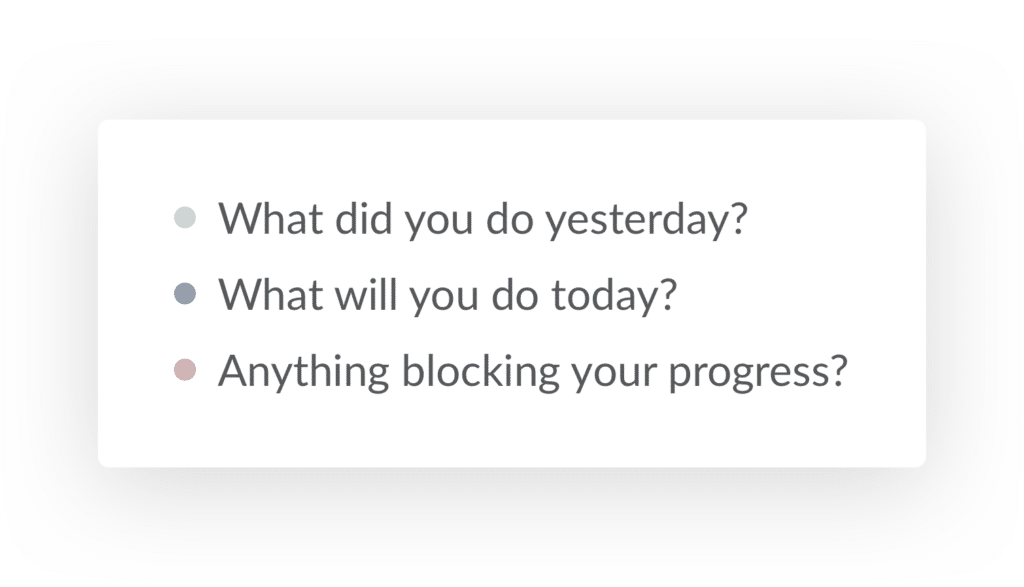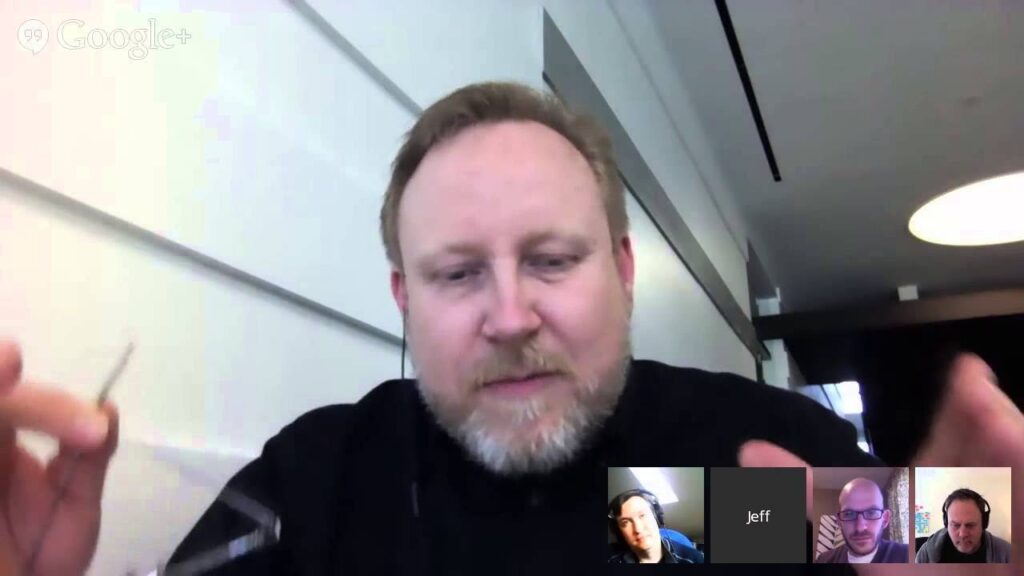A quick Google search will show you that the 3 daily standup questions in a scrum meeting are:
- What did you do yesterday?
- What will you do today?
- What (if anything) is blocking your progress?
But the problem with most articles on this topic is that they don’t elaborate on the following:
- What is the “why” behind these 3 questions?
- Are these daily standup questions actually effective? What are the common pitfalls?
- What are common frustrations that teams experience during standups as a result of these 3 questions?
At Geekbot, our engineering team has been running standups everyday for over 4 years — so we’ll go into detail on these topics using specific examples from our own experiences. In addition, we’ll share insights we’ve gained from our 100,000 users of Geekbot (a tool that lets teams run asynchronous standup meetings within Slack).
In this post, you’ll learn:
- Why There Are 3 Questions in a Daily Standup Meeting
- Non-Obvious Insights From the 3 Daily Standup Questions
- Common Pitfalls of the 3 Questions & How to Avoid Them [Unique Solutions + Specific Examples]
Geekbot lets teams replace tedious in-person standups with efficient, transparent standup meetings in Slack. Join our 100,000 users and thousands of companies who use Geekbot (like GitHub, Shopify, Airbnb, GitLab, and more) by signing up for a free 30 day trial of Geekbot here.
Why the 3 Questions in a Daily Standup Meeting?
At first glance, the purpose of the 3 daily scrum questions is relatively simple and obvious. These questions are asked routinely first thing in the morning, which allows teams to assess: (1) how they performed in the last 24 hours and (2) what the next 24 hours look like.
Or, more broadly, the 3 questions give insights into the 4 common intentions of any team check-in:
- Inspection: How is the team progressing towards their goals?
- Transparency: Is everyone on the team synced and up to date on what work has been done already, and what work still needs to be completed?
- Adaptation: Do we need to re-plan today based on events that happened the previous business day?
- Blockers: Is anything impeding individual team members?
The 3 scrum questions simply formalize this check-in process, so nothing gets missed.
While that may seem straightforward, we’ve actually found that the 3 questions also provide non-obvious insights/benefits that aren’t easily apparent to most teams. Below, we’ll discuss several eye-opening insights that teams can sometimes miss.
Non-Obvious Insights from the 3 Daily Standup Questions
1. What did you do yesterday?
Reveal Organizational Dysfunction (i.e. Too many meetings)
This question can reveal organizational dysfunction. For example, it’s common for team members to reply with, “I didn’t do much yesterday since the majority of my day consisted of meetings”. This could be a sign that your company isn’t operating effectively since employees don’t have time to actually focus on their work — so perhaps an organizational change is needed to address this.
Instead of being stuck at daily meetings, most engineers just want someone to give them the requirements for a project and let them go to work!
Complete Projects Faster (i.e. Get advice from team members who completed similar tasks yesterday)
The 1st question enables engineers to complete projects faster by learning from their team members. For example, an engineer might think that a certain task will take them 12 hours to complete. But during the standup, they might discover that yesterday, someone figured out how to complete the exact same task in 1 hour. With this newfound knowledge, an engineer can use the 12 hours that were saved to complete other tasks and reduce backlog… that way, they can take precautionary steps to avoid an uncomfortable conversation with a manager on why they didn’t finish a project on time.
Gain Insights on Engineer Traits (i.e. Find out if an engineer places value on high quality work)
You can gain insights about the traits of engineers by how they answer this question. For example, let’s say an engineer is supposed to perform a quick hack — but instead, they do a great refactoring job. This shows that this engineer places value on producing high quality work, since they were told to do a job a certain way (quick hack) yet they found a different method (refactoring) to perform higher quality work.
Address Unclear Tasks & Poor Project Planning (i.e. Create more well-defined task requirements)
The first question can reveal that your scrum team doesn’t have clear/well-defined task requirements, which is a result of poor project planning. For example, during standups, it’s common for engineers to say that they didn’t get much work done yesterday. If you ask them why, they have difficulty explaining what impeded their progress — if they can’t express why their work slowed down, then it could potentially signal they’re simply unclear about the task itself. In that case, your team should solidify the project plan and clarify any tasks which create confusion.
2. What will you do today?
Eliminate Tasks That Don’t Contribute to the Team’s Main Goal
The second question functions to analyze the team’s tasks for the day and filter out/eliminate tasks that don’t contribute to the overall goal of the project. Many scrum masters face this problem, and we’ll use a simple example to demonstrate this:
Let’s say the goal of a time-sensitive project is to increase the site’s speed. But during the standup, someone states they’ll work on debugging a problem today that’s completely unrelated to speeding up the website. Since it doesn’t contribute to the overall goal of making the site faster, standup attendees can point this out. This will cause the engineer to switch gears today in order to align with the team’s time-sensitive project objectives.
People Could Offer Help to Colleagues (i.e. If a colleague is working on a problem that someone on the team has already faced before)
Someone on your team may be tasked with solving a challenging problem… and there’s always a possibility that a colleague has already dealt with a similar issue. For example, let’s say John lets the development team know he’ll be debugging a specific problem today. Even though John may not say he’s stuck on anything during the standup, someone can jump in and offer to help by saying, “Hey, I actually worked on debugging a similar problem 2 days ago for another project — I learned a few things that could help, so just hit me up if needed”. This is the kind of serendipitous help and collaboration that can occur by doing nothing more than regularly sharing what you’re working on.
Discover Unintended Project Management and Planning Issues (i.e. Cross-overlap, dependencies, etc.)
When colleagues communicate to each other what they plan to do during the day, naturally it can lead to the discovery of several issues:
- Two colleagues may be working on a similar task without even realizing it — simple communication during the standup can help them avoid or undo cross-overlap.
- The whole team could realize that no one is planning to work on a critical task, because everyone figured someone else was handling it.
- This question can help uncover dependencies. For example, someone may say, “Oh, you’re working on that task today? Let me know how that goes because I need your task to be completed in order to start on ‘XYZ’.”
- This question can help you discover why a team member is not working on a specific task. For example, someone may realize, “Oh, my colleague is busy today with another task. At least now I know why they can’t help me with ‘XYZ’”. Knowing why people are busy and exactly what they’re working on helps make the workload more clear/understandable.
3. Anything blocking your progress?
Encourage Team Members to Help Each Other & Surface Blockers
The purpose of this question is simple and intuitive. Standup participants list anything that’s blocking their progress (and ideally highlight/prioritize urgent impediments). Then, team members are encouraged to jump in and help one another surface/eliminate blockers.
Some common examples of impediments are:
- I don’t have experience using ____ so I need to meet with someone who’s well-versed in it.
- I’m having trouble debugging a problem related to ____.
- I need approval from ____ to do ___.
- I need help repairing ____ because it stopped working.
What To Say In a Standup Meeting? (Examples)
Question 1: What did you do yesterday?
Tips:
- Be direct, don’t worry if your reply is short
- Don’t focus too much on details, focus on value and team collaboration
- Try avoiding vague “I continue working”. That might demotivate your colleagues
- Whenever possible, mention your colleagues you collaborated with to boost team morale
Answer 1: “I just wrapped up working on [feature] from [project]. I found a bug that was causing an error on the front end and shared my findings with Max who helped me send a bug report to Q&A. “
Answer 2: “I was working with Sarah on our latest email campaign. We updated our main template and set up subscription analytics to track how many people unsubscribe during our promotional emails.”
Question 2: What will you do today?
Tips:
- You don’t have to outline your whole day, it’s enough to outline the main task you’re trying to accomplish, or you can group several smaller tasks into one “debugging” project.
- Try not involving other people when you are sharing plans if they haven’t committed yet to avoid putting them on the spot
Answer 1: “I plan to continue reorganizing our database for improved performance. I also will look into the latest bug reports and see which ones might be relevant to my current task.”
Answer 2: “We want to export the database of support tickets and analyze how often people mentioned our request feature and if it need to update it. It’s part of our epic on improving yearly NPS score.”
Question 3: What (if anything) is blocking your progress?
Tips:
- Avoid blaming your teammates
- Propose solutions
- Don’t try to fix issues during daily standups, schedule follow-up meetings if necessary
Answer 1: “I ran into an issue with merging project branches, I would appreciate some help from our DevOps to figure this one out.”
Answer 2: “I am getting low response rates from our latest SMM campaign, can someone from marketing spend an hour with me and update our messaging?”
15 More Standup Questions To Prevent Standups From Going Stale
Standups can become stale and disengaging for different reasons. Your team might be working on routine tasks and their reports are becoming repetitive. Your team might be thinking of daily standups as status updates and feel overly micromanaged. Or your daily standups are too long and lack focus.
A good exercise to shake up things and boost engagement during standups is to add the 4th questions, that serves both as an icebreaker and well-being meter.
Here are examples of questions to add during your standups:
- What is one present you will never forget?
- Tell us one thing that you really like about yourself.
- How would you spend your time if you had a time machine that could only be used once? Which point in history or the future would you choose to visit?
- What would you do differently if this week were to repeat itself?
- What animal would you be and why?
- Would you prefer a cat or a dog as a pet?
- If you find a dead insect in your salad at a friend’s or relative’s house for dinner, what would you do?
- You could have an endless supply of any food. What would it be?
- This past week, what was the best thing that happened to you?
- What movie, book, or video did you watch/read recently that you would recommend?
- Who did you want to be when you were growing up?
- If you could have dinner with anyone, living or dead, who would it be?
- If your life was turned into a movie, what kind of film would it be? Would it be a drama, a comedy, a romantic comedy, an action film, or science fiction?
- If your life were made into a movie, who would you want to play you?
- Which chocolate bar would you be if you were one?
Common Pitfalls of the 3 Questions & How to Avoid Them? [Unique Solutions + Specific Examples]
Before we dive into the common pitfalls, we’d like to preface it by saying that these questions are in the official Scrum Guide for a reason — they are the cornerstones of agile. They were carefully chosen and a lot of thought was put into them to ensure they achieve the goals of standup meetings in scrum methodology.
If you avoid making the common mistakes we discuss below, then the 3 questions will benefit your team in multiple ways (as we detailed in the previous section). Through our talks with Geekbot customers, we’ve noticed that some teams don’t answer these questions properly, which can lead to a few problems:
The 3rd Question Can Lead to Decision Making During Daily Scrum Meetings (Resulting in Longer Meetings Than Anticipated)
The 3rd question (“Anything blocking your progress?”) often leads to multiple people discussing a blocker during the standup — we’ve seen meetings go over as much as 1 hour because of this.
For example, let’s say John raises a blocker. Then, Blake says, “I can help you with that!” … but Randy says, “I can also help you with that”… and Jerry says, “Oh, I also happen to be working on that”. So multiple people huddle and start discussing the blocker, which leads to decision making during the standup. Naturally, this may cause the meeting to last half an hour instead of fifteen minutes.
To add insult to injury, this blocker may not even apply to half the people in this daily scrum. So several engineers have to sit there and listen to non-relevant information instead of spending that time on important work that may be time-sensitive.
Here are some solutions to help solve this problem:
- A good facilitator here will say, “Why don’t you guys just have a call after the meeting in order to solve this problem”.
- A project manager or lead can jump in and make a quick, decisive decision to eliminate the blocker (instead of letting participants ramble on indecisively).
- If someone directly asks a specific person for help with a blocker, a good response can be “OK, I will talk to you later to find a solution for that”.
How Geekbot Helps Solve the Problem of Lengthy Decision Making in Standups
We actually think that Geekbot naturally lends itself to helping solve this problem by letting teams run effective standups in Slack instead of in person, because Slack lends itself to folks discussing specific projects and helping each other without involving every single person on the team.
More specifically, Geekbot lets your team run asynchronous standup meetings inside Slack, by sending a direct message within Slack to standup participants asking them the 3 daily scrum questions:
- What did you do yesterday?
- What did you do today?
- Anything blocking your progress?

After you answer the 3 questions, Geekbot will post the answers in a public Slack channel that the entire team can view and pitch in with a comment on the spot. Then, folks can tag each other in their answers, folks can have sidebars to discuss issues in threads or in DMs, and overall, team members can help each other without wasting everyone else’s time.
But the fact that answers are completely transparent to the whole team (not just the manager) by being in a public channel helps keep everyone accountable, and on the same page, as illustrated by the example below:
Last week, one of our engineers at Geekbot DM’d an outsourced designer we often collaborate with. The engineer needed help with an impediment. But the engineer was ignored and never got his message answered. However, when he mentioned the designer in one of his blockers during an official Geekbot Slack standup using “@name”, the designer replied immediately (both in the public Slack channel where the standup answers were posted and directly via DM).
Since the whole team could see the designer was blocking this engineer, the designer probably felt peer pressure to reply more quickly.
In an in-person standup, this blocker could’ve resulted in a long conversation — for example, the designer could’ve asked “what exactly do you mean by that blocker?” or defend themselves somehow — the engineer would’ve had to respond to that and elaborate on the blocker, thus extending the meeting time. But instead, the blocker was addressed using Geekbot’s In-Slack standup quickly via an “@Name” mention. So other people on the team didn’t have to waste their time listening to an in-person conversation about a blocker that wasn’t relevant to them.
By running daily scrums inside Slack using Geekbot instead of in-person, it significantly speeds up standups, giving engineers more time to focus on their work… which is why we use Geekbot ourselves everyday along with 100,000 users (and companies like GitHub, Shopify, Airbnb, GitLab, and more). Sign up here to try Geekbot free for 30 days.
Engineers Who Answer the 1st Question May Take Way Too Long or Get Off Track
From our experience, the 1st question (“What did you do yesterday?”) can sometimes take way too long. When you’re asking someone what they’ve done, some people keep talking on and on and don’t know how to find the threshold of what people truly need to hear, and what’s superfluous.
Instead of just quickly saying what they did, some engineers back it up with unnecessary details to make their efforts seem more impressive.
How Geekbot Solves This Problem
Geekbot also naturally solves this in two ways: (1) Folks that ramble tend to do it in person, not in writing, which obviously requires more work and thought. (2) Everyone else can skim long answers. You don’t have to sit (or stand!) and listen to them say every word. If the update doesn’t have to do with you, then you can move on.

Engineers Talk About Effort/Progress Instead of Actual Completed Tasks
This is a more subtle problem with the existing standup questions but an important one. Several months ago, a few of our engineers were in a webinar with Jeff Patton and Jeff Gothelf (two experts who are well known in the agile & lean ecosystem). They’ve published books like “Lean UX” and “User Story Mapping”.

We asked them if they had any recommendations to all the people who dislike standups and they suggested an interesting twist on the normal 3 questions that are meant to:
- Depersonalize: Refocus the answers in terms of jobs to be done instead of being about that person and their day.
- Add more focus on actual and projected completion dates so large tasks get more interesting updates.
Instead of using the well-known 3 questions, here are 2 alternative questions they suggested asking:
- What [tasks] have you finished?
- What [tasks] are you going to finish and by when?
These questions are meant to solve the repetitiveness and clarity problems by focusing on completion timelines of specific tasks. Here’s how:
The answers to the 2 questions above end up focusing around tasks and completion dates, which de-personalizes the discussion. Instead of a discussion on what this one person is working on and what they did, it moves the discussion to the tasks, which is more team focused and objective focused. “I finished the debugging of ‘X’ yesterday. I’m likely going to finish the setup of ‘Y’ by Friday.”
In addition, this makes updates on large tasks a lot more interesting. For example, let’s say an engineer has been working on the same task for 10 working days. Their answers using the 3 conventional daily scrum questions would get repetitive:
- What did you do yesterday? Task ‘X’.
- What are you doing today? Task ‘X’.
- Any blockers? Yes/no.
For 10 days they’d give this same answer. If there aren’t a lot of blockers, this could get tedious.
But instead, if you take a task-focused approach, you can say: “Right now, the estimated completion date for ‘XYZ’ is April 20th”. And if that date gets delayed, you can say “The completion date for ‘XYZ’ has been delayed to April 28th due to [Insert Reason]”.
This allows the team to see whether or not tasks are on track.
The focus on tasks instead of the person promotes more sharing during standups since team members are less afraid of their boss questioning them on a personal level versus focusing on the task itself.
We have not personally tried this at Geekbot but it’s an interesting idea from Patton and Gothelf that we think is worth trying.
Tired of daily scrums that last too long, disrupt your workflow, and are difficult to schedule due to time zone differences? Sign up for a free 30 day trial of GeekBot here to run asynchronous standup meetings — ideal for remote teams. Join our 100,000 users and thousands of companies who use Geekbot (like GitHub, Shopify, Airbnb, GitLab, and more).
Frequently asked questions
What are the three questions asked in daily standup call?
Here are the three questions that every team member answers during a daily standup call: 1. What have you completed since the last meeting? 2. What are you going to finish by the next meeting? 3. Is there anything that stands in your way?
How can I make my daily stand up interesting?
There are many ways to make your daily stand up meeting more interesting and engaging. You can add a 4th short question, for example “What movie you watched during the holiday”. Another way is to keep them under time and ensure that every team member speaks the same amount of time. Finally, make a tradition of starting daily standups with a funny joke or a customer testimonial.
What is Agile standup meeting?
Agile stand up meeting is one of the main agile ceremonies that lasts no longer than 15 minutes and encourages agile team members to share their current progress, next goals, and challenges that affect their current work by answering a set of three well-defined questions.



